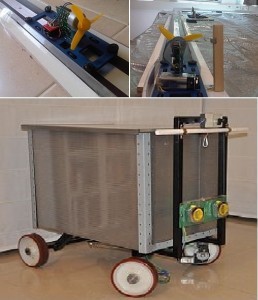Students at the Technion develop a magnetic car that floats in the air and a toolbox that follows its owner
 The Technion program for autonomous systems held an unmanned autonomous model design and building competition among undergraduate students. The winners of this competition were Erez Horev of the Faculty of Civil and Environmental Engineering, who developed a magnetic car that floats in the air, and Doron Le’or of the Faculty of Mechanical Engineering, who developed a motorized toolbox that follows its owner.
The Technion program for autonomous systems held an unmanned autonomous model design and building competition among undergraduate students. The winners of this competition were Erez Horev of the Faculty of Civil and Environmental Engineering, who developed a magnetic car that floats in the air, and Doron Le’or of the Faculty of Mechanical Engineering, who developed a motorized toolbox that follows its owner.
The model constructed by Erez simulates a magnetic toll road for private cars. The car travels both on the road and on magnetic rails (without its wheels touching the ground). “Because of the high speeds that can be reached using this technology, the project can compete not only against existing toll roads but even against domestic air and train travel,” stresses Erez. He worked in the past on Route 6 and then on the Metronit Project (the Haifa light rail system) and it was then that the idea popped into his head. It took him half a year to build the model, having to overcome challenges presented by magnetic fields and magnetic stabilization. He used four vehicles: one works by propulsion and another by attraction. One model was equipped with a controller that switches between travel with or without the use of a magnetic field. Each vehicle had a propeller and a sensor that communicated with a sensor on the road.
“The vehicle can travel at speeds of 400 k/h while its driver can go to sleep,” says Erez. “It suits long roads without exits. True, the cost of such a road and the vehicle is high, but on the other hand, there is an enormous saving in fuel and especially of human life, given that the chances of having an accident are zero. When the magnetic road ends, the driver engages the wheels and continues driving normally.”
Doron Le’or built a model of toolbox that follows its owner. He had worked in the past as a maintenance man in the Dan kibbutz factory, and lugged his heavy toolbox around for him. This toolbox weighed 100 or more kilos. Le’or made the toolbox that follows its owner electric, with an electro-mechanical sensor. “The model was built according to several guiding principles,” says Doron. “First, we focused on the main technological problem, and avoided as much as possible other knowledge gaps. Second, the integrated propulsion and steering system has implications for the world of cars and had to be studied accordingly. Third – the model had to be built within four days and without going overbudget so a way had to be found to replace the expensive electrical components with less expensive parts that can do the same tasks, as for instance a multi-rotating potentiometer connected to a simple measuring meter that converts the distance a person is from the toolbox into electrical tension as a substitute for an ultrasonic sensor or a solid state relay that works at intervals and propels the motors at varying speeds as a substitute for a current regulator.”
In order to operate the model, Doron together with his friends in the factory, built a metal skeleton on top of which the toolbox was installed. At one end, they installed a pair of distance measurers and underneath it, they attached four wheels. The two front wheels moved independently and were attached to each other by a steering rack. When the maintenance man attaches the distance meter to his belt and activates the instrument, an industrial controller reads the potentiometer tension and activates the motors so that the distance between the toolbox and its operator stays fixed. The difference in speeds between the motors creates the steering and directs the toolbox directly to the maintenance man.
Above: The magnetic car and the toolbox. Photo: Erez Horev and Doron Le’or


